1. Introduction
Institutionalizing science to achieve economic development in Latin American countries has been up for discussion for the last 20 years [1]. There are several reasons for emerging countries like Colombia to show research interest, which has created a competitive culture that contributed, in turn, to boost innovation, both of which stimulate economic growth [2]. Moreover, research may directly impact population health, influence government politics, and decisions in topics related to health and the environment, and constitute the first step towards building new processes that allow sustainable growth [3].
Engineering is an area of knowledge of economic interest, and consequently, of strategic importance. Investment in engineering research has proven to have up to a 30% rate of return [4]. However, Colombia invests less than 1% of its GDP in research and development [5]. The country is currently investing in increasing this Figure to 1.5% in the next years [6].
Science can be defined as what is published in academic journals, and scientists would, therefore, be those who collaborate in publishing [7]. Though this is not the only definition, it shows how relevant scientific publications are to science. They enable scientists to exchange information throughout the scientific community and enables the community to quantify its research, researchers, and responsible entities by describing their scientific production [8].
On the other hand, bibliometrics uses statistical methods to analyze information related to publications and journals and, therefore, constitutes an adequate way to measure investment in science and the amount of research conducted in a country or an institution. For these reasons, there is an interest in studying engineering scientific publications in Colombia and performing a bibliometric analysis, as it grants an opportunity to contrast the amount of research done by different academic institutions in Colombia. This analysis aims to understand the publishing trends in engineering in the country, as well as to underpin where this knowledge is being produced to consequently set the foundation over which objective decisions can be made.
2. Methodology
A descriptive retrospective bibliometric analysis was made on the topic of engineering during the 2010-2019 decade. With this objective in mind, there is a wide variety of tools to be used.
2.1 Database selection
The literature review shed some light on the effectiveness of using databases in systematic scientific publication search and revision [9]. When comparing popular databases such as Google Scholar, JSTOR, and IEEE Explorer, among others, it was evident that such databases are not as useful as expected when interpreting search parameters and effectively recovering information in replicable way. This paper focuses on databases with a multidisciplinary approach and more than 50,000,000 publications. The databases meeting these criteria are listed as follows: Scopus, Web of Science, and Biefeield Academic. They were all considered for this study.
When comparing Scopus, Web of Science, and Biefeield Academic, it was found that the number of Colombian publications indexed under the engineering field in Scopus is 19,843, compared to the 14,519 publications found in Web of Science and the 1,396 in Biefeield Academic. Scopus has approximately 27% more publications that meet the criteria mentioned above than Web of Science and 93% more than Biefield Academic. Therefore, Scopus has shown to have a wider representation of the scientific publications of interest and was the study's tool.
2.2 Information collection process
In Scopus, the scientific publications were filtered by publication year between 2010-2019. Initially, they were also filtered by the engineering field of study to compare publishing trends in Latin America. Later, the field of study filter was replaced by country affiliation. Hence, the publications were limited to those published by researchers affiliated with any Colombian institution. Once those parameters were established, the institutions in all areas of knowledge were studied. Finally, the publications were filtered once again by the engineering field of study, the results were also analyzed.
Additionally, information regarding the authors meeting the criteria was also collected-specifically, the H index and the self-citation index. The self-citation index was calculated by dividing the number of self-citations by the number of total citations.
3. Results
According to Scopus, there were 5,922,319 publications in engineering during the 2010-2019 decade. Table 1 presents the number of scientific publications on engineering during this decade in each of the top 10 publishing countries in Latin America. Similarly, Fig. 1 presents the five countries' publishing trends with the highest number of engineering publications in Latin America. In Fig. 2, Mexico and Brazil were filtered out to see Colombia's publishing trend in detail.
Table 1 Latin American countries with the highest number of scientific publications on engineering during 2010-2019. Total number of publications since the record began. Number of publications during the decade. Percentage of the decade's publications considering the total amount of publications.
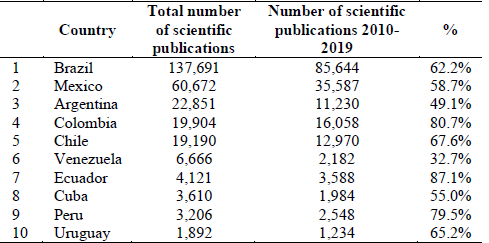
Source: Elaborated by the authors.

Source: Elaborated by the authors.
Figure 1 Publishing trends of the five Latin American countries with higher number of scientific publications in engineering.

Source: Elaborated by the authors.
Figure 2 Colombia, Chile, and Argentina's publishing trends in engineering.
Colombia reports 121,801 scientific publications in Scopus, out of which 19,843 (16.3%) were indexed under engineering. Table 2 exhibits the top 10 universities with the highest number of publications in all fields of study in 2010-2019. Likewise, Table 3 presents the 20 universities with the highest number of scientific publications indexed under the engineering field of study.
Table 2 Colombian universities with the highest research output in all fields of study; publications during the 2010-2019 decade; and the percentage this figure represents of the total output.
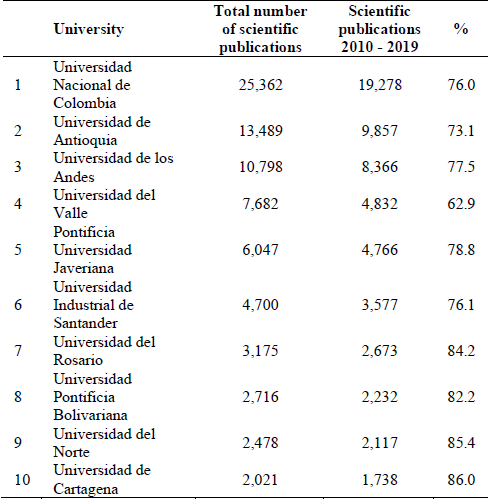
Source: Elaborated by the authors.
Table 3 Colombian universities with the highest number of scientific publications in engineering; total number of publications in engineering, publications in engineering during the 2010-2019 decade, and the percentage this figure represents of the total output.
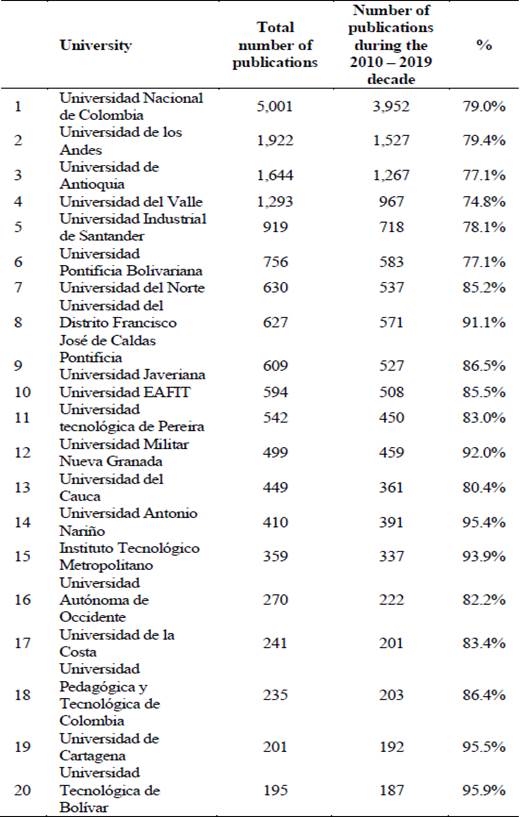
Source: Elaborated by the authors.
Fig. 3 represents the percentages from Table 3 graphed against the percentages from Table 2 for the five universities with the highest publication output in engineering. Additionally, a trend line was added, which illustrates where the institutions should be placed if both values were the same.
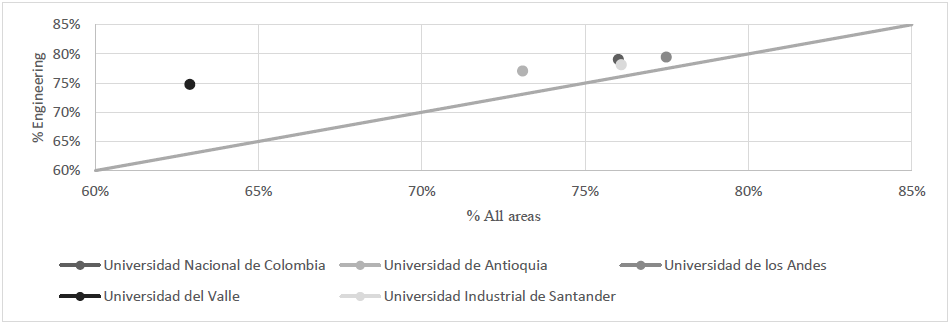
Source: Elaborated by the authors.
Figure 3 Comparison between the growth in publication output in engineering during the 2010-2019 decade and the total scientific output during the same decade for the five universities with the highest output in engineering.
Fig. 4 presents the publishing trends for the five universities with the highest research output during 2010-2019.
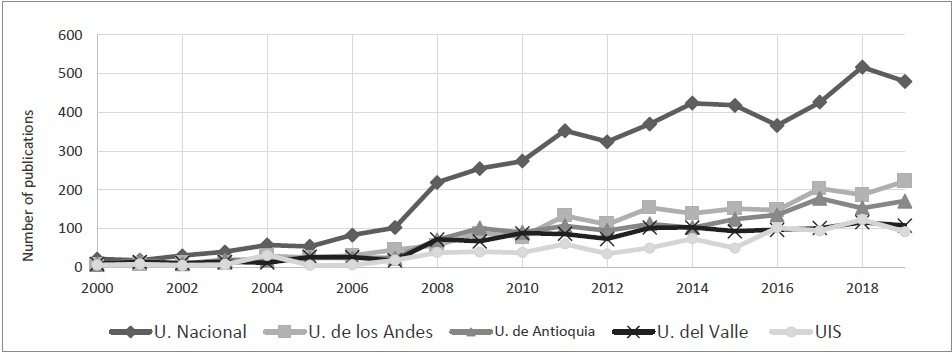
Source: Elaborated by the authors.
Figure 4 Publishing trends in the five universities with the highest publication output in Colombia.
Table 4 also presents the 40 authors with the highest number of engineering publications in the 2010-2019 decade, who were also affiliated with a Colombian institution and whose identity was fully disclosed. Table 4 also presents the institution to which each of the authors was affiliated, the number of indexed publications under engineering in the given decade, the number of citations received, their H index, and the self-citation index.
Table 4 Top engineering researchers affiliated with a Colombian institution during the 2010-2019-decade, institution to which they are affiliated, number of indexed publications under engineering, number of citations, H index for those publications, and self-citation index.
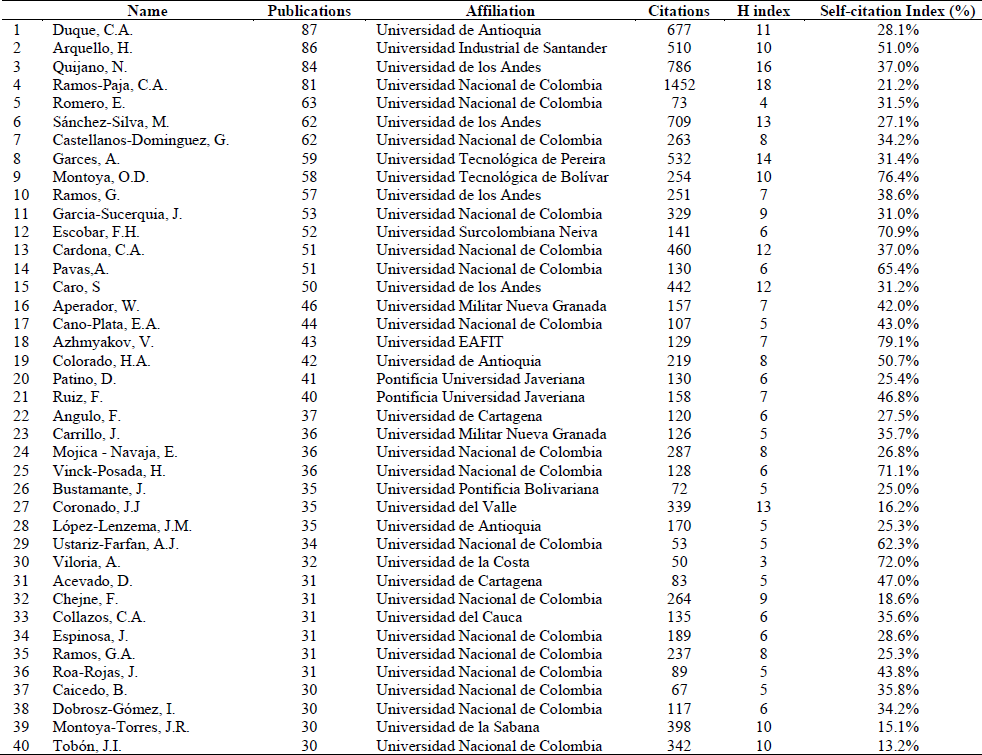
Source: Elaborated by the authors.
4. Discussion
Table 1 shows that Colombia belongs to the top 5 Latin American countries with the highest scientific output in engineering. During this decade, Colombia published 80% of its average scientific publications in its entire history, so it became the second country with the highest publishing growth, after Ecuador. Figure 1 shows Brazil ahead compared to the rest of the Latin American countries, followed by Mexico. As shown in figure 2, Colombia published a lower amount of papers than Chile and Argentina during 2000-2010; nevertheless, after 2011, Colombia started to publish more than these countries. And, up to 2019, this trend has not stopped, except for 2016, when Chile surpassed Colombia by 70 publications.
When comparing Tables 2 and 3, the ranking of Colombian institutions in all areas of knowledge does not correspond with the order for engineering publications; changes start in the second position. Nevertheless, the publishing percentage remains above 60% for all institutions in all study fields and above 70% in engineering publications.
This trend may indicate a higher overall growth in the number of engineering publications as compared to "all the fields of study" publications. This can be seen in Figure 3 when comparing the growth in the number of publications for other fields of study with the growth of engineering publications during the same decade. This Figure clearly shows that the five universities with the highest scientific output have had higher engineering growth than in their overall publications. This trend can be seen at Universidad del Valle, which had considerable engineering growth over their overall publications (11% deviation compared to the trendline).
In the bibliometric analysis of scientific production of 1997-2009 conducted by Rojas-Solas, Universidad Nacional was pinpointed as the institution with most engineering scientific publishing in Colombia. In those days, their publications represented 49% of the country's total engineering publications [10]. Although Universidad Nacional is still leading Colombia's scientific output, its participation has decreased due to new participants' entry. In figure 4, Universidad Nacional is the institution with the highest growth in scientific production, followed by Universidad de Los Andes, whereas Universidad de Los Andes had the highest growth during the last decade.
Regarding the authors in table 4, those with the highest number of publications do not necessarily belong to the entities with the highest publication output showed in table 3. Additionally, the authors with the most publications do not necessarily have the highest number of citations or H index reports since many publications can be related to research on a broad number of topics [11]. On the other hand, the authors with a high number of citations do not necessarily have the highest H index, which may be linked to frequent participation in joint publications with a low number of citations [12] since the H index is benefited by a high number of low-to-mid impact publications over a low number of high impact publications [8].
The self-citation indexes in Table 4 are ranged from 13% to 79%; nonetheless, it is difficult to dismiss the possibility that some of the authors with a high self-citation index work in lines of research with less information, which would demand work over their own scientific production, and thus, they would be forced to self-cite their work. Nevertheless, some authors' possibility of taking advantage of their position as research group leaders to increase their number of citations is not discarded [13,14].
5. Conclusions
Engineering research in Colombia has proved to have a growing trend, both in the relative number of publications and the overall national scientific production. This trend has shifted from previous years, mainly due to investment from the public and private sector, such as universities, as well as Colciencias and now the Ministerio de Ciencia y Tecnologia [15], which allowed Colombia to be positioned as a benchmark of research in Latin America. However, the country continues to rank in the 53rd position in the worldwide benchmark, which is currently led by countries such as the United States, China, Japan, the United Kingdom, and Germany. Despite being labeled as an adequate search tool, Scopus presented problems when searching for authors affiliated to specific regions. For example, some authors may not have any affiliation to the region, and hence their identifications were not provided at first by the search machine. Special data treatment is advisable for such or any other cases.
Additionally, it is worth mentioning Universidad Nacional's decrease in its representation in the country's overall scientific output is caused mainly by the increasing growth of other entities' scientific output, even though it still leads in research growth in the topic of engineering.
For future research, given the above, it is advisable to study further the impact of Colombian researchers and entities' publications.














